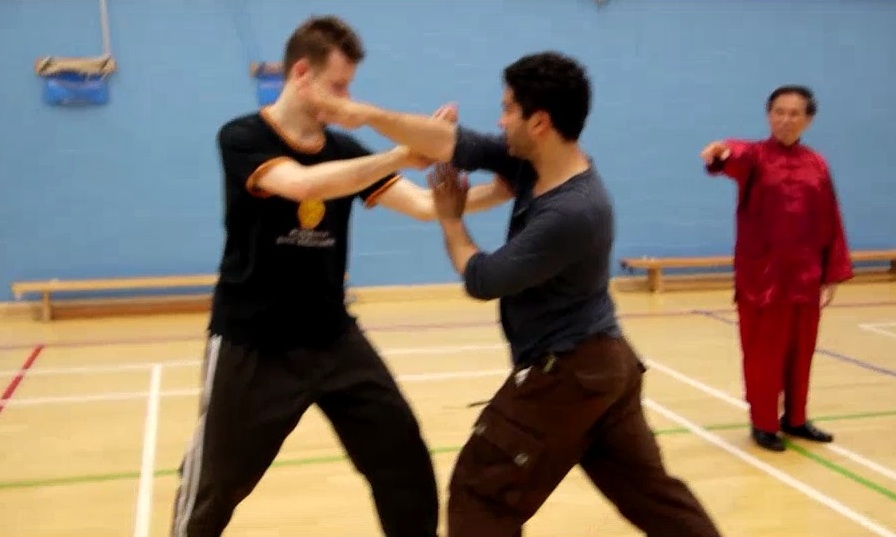DISCOVERIES AND BENEFITS FROM THE LEGACY COURSE

One invaluable benefit form preparing the Drunken Eight Immortals course was to discover how to counter any pin-down
Question 5
In preparing the course material for other courses such as: The Legacy of Wong Fei Hung, The 8 Drunken Immortals, Choe Family Wing Chun and Bagua Zhang, to name a few, Sifu made some important discoveries about those arts.
In preparing for the Legacy of Zhang San Feng what new or distilled discoveries about Taijiquan has Sifu discovered or have been revealed?
Sifu mentioned that the Legacy of Zhang San Feng course will bring a greater depth and understanding of the teachings of Taijiquan, as they were originally practiced by this great master. What can someone expect from this course that has already learnt incredible Taijiquan skills from you?
Sifu Tim Franklin
Answer
I myself benefited a lot in both my practice and teaching when I prepared course material for courses like the Legacy of Wong Fei Hoong, the Eight Drunken Immortals, Choe Family Wing Choon, and Baguazhang.
For fun, and also for educational purposes, I shall name a benefit for my own practice and for my teaching in each of the courses. Please note that the benefits named may or may not be the most important, they just come to mind at the time of writing.
Legacy of Wong Fei Hoong -- the Fifth Brother Eight Octagonal Staff became more formidable when it was used like the Wing Choon Six-and–Half-Point Staff -- systematic transition form level 1 to level 2 to level 3 in staff application.
Eight Drunken Immortals -- all the take-downs and pin-downs in Wrestling can be found in Shaolin Kungfu though most Shaolin practitioners may be unaware of them -- learning the secret to overcome any pin-down.
Choe Family Wing Choon -- Waist rotation in Taijiquan has greatly enriched my Wing Choon combat application-- the methodology we used in blind-fold chi sau was very effective.
Baguazhang -- Baguazhang uses three planes, Taijiquan two, and Shaolin Kungfu one -- getting to the back of an opponent is not difficult.
In preparing for the Legacy of Zhang San Feng, the most noticable discovery and aha experience is that Wudang Taijiquan is more like Shaolin Kungfu than Taijiquan. This is no surprise to me as I know that at the time it was called Wudang Shaolin Kungfu. The term “Taijiquan” was known a few centuries later.
Another discovery is that Wudang Taijiquan is the pinnacle of Shaolin Kungfu development, and the source of all styles of Taijiquan. This has much significance in our school, as our kungfu is also chi kung and meditation, which was first developed by Zhang San Feng.
This discovery is also of much significance to all Taijiquan practitiones of the world. It reminds them that Taijiquan was first practiced for spiritual cultivation, and that Taijiquan is very effective for combat and for health. Many Taijiquan practitioners, regretablly, practice their great art as a dance, often with injury to their knees and back.
Another discovery and aha experience are that Wudang Taijiquan is very similar to Dragon Strength in spirit, principles and practice. While the main “animal” of most Taijiquan practiced in the world today is the Snake, that of Wudang Taijquan is the Dragon. For those not familiar with Eastern culture, the Dragon is a great majestic divine creature biringing prosperity and harmony. The internal force in Wudang Taijiquan and Dragon Strength is also quite similar.
The Legacy of Zhang San Feng course will bring a greater depth of understanding not only to Taijiquan but also to all kungfu styles. When Wudang Taijiquan is the pinnacle of Shaolin Kungfu development, and Shaolin Kungfu is the best of all martial arts, no matter what styles of kungfu a practitioner practices -- irrespective of whether it is Xingyiquan or Baguazhang, Wing Choon or Choy-Li-Fatt, Tantui or Lohan Fist -- he (or she) will certainly benefit a lot from attending this course. He may, for example, apply the training methodology of Wudang Taijiquan to enrich his combat application of Wing Choon Kungfu, or to develop internal force for Tantui.
Besides many other benefits, those who already have learnt Taijiquan skills from me, will learn two additional skills. They will learn to select appropriate parts form their Taijiquan sets for their specific purposes, and to compose a Taijiquan set for their own use or to teach others. For example, if they want to counter kicks, they would learn to select appropriate sections form their sets to practice. If they teach a class of children, they will compose a special set for this purpose, which would be different, for example, from a set for elderly people.
Indeed these two additional skills are not just for Taijiquan practitioners, they are for all kungfu practitioners. If you have learnt Xingyiquan from me, for example, and wish to be effective in your free sparring with other martial artists, to be cost-effective for this purpose you need not practice the whole of the two sparring sets of Five-Flower Cannon and Safe-Body Cannon. You can select suitable techniques from this two sparring sets, or from Xingyiquan in general for your training.
If you have learnt the Drunken Eight Immortals from me, and now teach a class of business executives, the rolling and felling of Drunken Eight Immortals may not be suitable for your purpose. But you can select suitable techniques from the Drunken Eight Immortals to compose into a set to teach the business executives to fulfill their needs.
The Legacy of Zhang San Feng course will be full of fun and benefits. It will not only enrich our kungfu and chi kung, but also our daily life.

The Legacy of Zhang San Feng course will benefit practitioners of any kungfu style, such as Xingyiquan
The questions and answers are reproduced from the thread Legacy of Zhang San Feng: 10 Questions to the Grandmaster in the Shaolin Wahnam Discussion Forum.
LINKS
Courses and Classes
